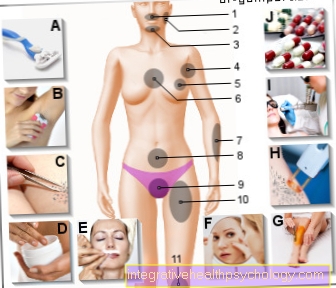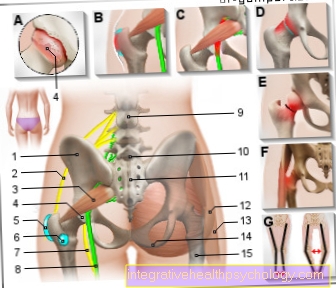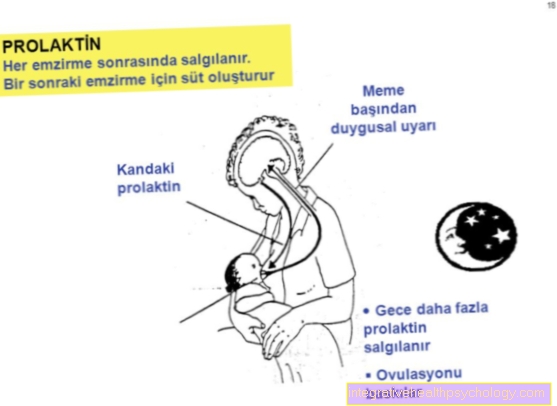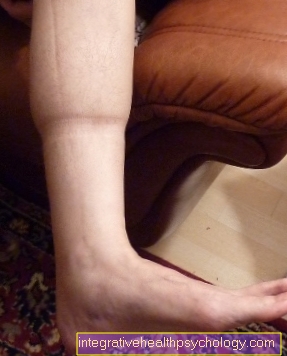Eye drops containing antibiotics
introduction
Eye drops are oily or watery drugs that are placed in the eye and are effective there. There are many different types of eye drops, the most important of which are antibiotic eye drops, eye drops that lower the eye pressure, and drops that help relieve dryness or irritation of the eyes. Eye drops containing antibiotics are mainly used for infectious diseases of the eye, such as prescribed for conjunctivitis or given as prophylaxis against infections. In certain cases, eye drops containing antibiotics can also be given in combination with cortisone.

effect
Depending on the preparation, the eye drops containing antibiotics work by inhibiting the bacterial cell wall, the proteins formed by the bacteria, or by inhibiting the bacterial, genetic level. Important antibiotics that can be given in the form of eye drops include Ciprofloxacin, erythromycin, tetracycline or doxycycline, gentamycin, kanamycin and neomycin, as well as chloramphenicol.
In addition to the dosage form as eye drops, there are also eye ointments with antibiotics. They linger longer in the eye so that the active ingredient can target the site of the infection. Ointments in the eye often cause blurred vision.
Learn more at: Eye ointment containing antibiotics
Active ingredients
The following eye drops / ointments are used: aminoclycosides (gentamycin, Kanamycin, Neomycon, Tobramycin: act against staphylococci, Enterobacteriaceae but not against chlamydia and pneumococci). These eye drops should be dripped into each eye 3-6 times a day. Gentamycin (Refobacin®) is also available as an ointment.
Another group of antibiotic eye drops are the gyrase inhibitors (Ciprofloxacin and Ofloxacin), which have a very broad spectrum of activity and are also effective against chlamydia. Other broad-spectrum antibiotics would be: chloramphenicol (also as an ointment), chlortetracycline (also as an ointment), ciprofloxacin, erythromycin (also as an ointment), fusidic acid, lomefloxacin, levofloxacin, oxytetracycline (also as an ointment). The eye drops should all be taken between 2 and 5 times a day.
Floxal®
Floxal® eye drops contain the antibiotic ofloxacin. It can be used when the eye is infected with bacteria, with which inflammation of the cornea, the conjunctiva, the edge of the eyelid and the eye sac can be effectively treated with the eye drops. It is important that such antibiotic eye drops can only develop their full effect if there is actually a bacterial infection. Otherwise they lead to an alleviation of the symptoms due to moisture, but cannot fight the pathogens themselves. Floxal® eye drops should generally be dripped into the eye three to four times a day.Overall, a treatment duration of two weeks should not be exceeded. Side effects can occur especially in the case of allergies and hypersensitivity to the active ingredients contained in the Floxal® eye drops. This can lead to itching and burning of the eyes as well as reddening of the conjunctiva. Floxal® eye drops can also be used for treatment of stye. This is the bacterial inflammation of a gland on the eyelid. Usually the lid swells painfully in the affected area and is also reddened.
Read more on this topic at: Floxal® eye drops
Drops containing antibiotics or cortisone drops?
Eye drops containing antibiotics are sometimes used in combination with cortisone. The antibiotic active ingredients can fight the pathogen (bacteria), while the cortisone mainly works the immune reaction of the body and thus reduces the irritation of the eye. Typically, cortisone in eye drops is only used for non-infectious inflammations, as cortisone inhibits the body's immune cells in their work. If you still want to take cortisone with an infectious cause of eye irritation, it is only recommended in combination with a preparation containing antibiotics. Otherwise, the immune response is downregulated and the bacteria can continue to inflame the eye. The complaints usually persist for a longer period of time.
Eye drops with cortisone are also mostly used as combination preparations for the therapeutic lowering of intraocular pressure, for glaucoma or infections. Cortisone is particularly successful in conjunctivitis caused by allergies. Possible side effects of eye drops containing cortisone can be secondary infections, corneal damage and an increase in intraocular pressure. Therefore, these eye drops should only be taken for a limited period of time.
In the case of conjunctivitis caused by bacteria or viruses, eye drops containing cortisone usually do not help.
Are the drops available without a prescription?
Eye drops containing antibiotics should not be used for every irritation or inflammation of the eye. Conjunctivitis should always be clarified by a doctor, as there can always be a bacterial cause for the inflammation. This would entail therapy with eye drops containing antibiotics, because eye drops containing antibiotics only make sense if the inflammation is based on an infection with bacteria, since the antibiotics can only treat bacteria and no other pathogens. These antibiotic eye drops require a prescription and are issued by a doctor with a prescription. Some eye drops containing antibiotics are available online without a prescription, however an ophthalmologist should assess the condition of the eyes before using eye drops containing antibiotics.
But there are also over-the-counter eye drops that do not contain antibiotics, but can also improve symptoms. So-called film formers such as Lacrimal® or Berberil® moisten eyes by replacing the missing tear fluid. This can help relieve symptoms such as burning eyes or itchy eyes. Since film formers do not contain any preservatives, they can be taken for a long time without any problems.
Difference between eye drops with and without preservatives
As with many foods, preservatives are often added to eye drops as they have a longer shelf life. However, these substances can quickly destroy the effect of the eye drops, as they dry out the eyes and thus increase the irritation. That is why many of the eye drops containing antibiotics are now made without preservatives. In addition, in contrast to in the past, significantly fewer harmful preservatives are used nowadays, so that eye drops containing antibiotics with preservatives no longer dry out the eyes as much.
application areas
Eye drops containing antibiotics are used to treat infections of a bacterial nature. These include primarily conjunctivitis (Conjunctivitis) and corneal inflammation (keratitis). It is important to use the preparations regularly and closely. Since eye ointments usually stay in the eye longer, they cause greater visual impairment.
For this reason, it is advisable to take eye drops during the day and eye ointments at night. Most antibiotics cannot penetrate an intact cornea, which makes them less effective. If it is a corneal inflammation, this is possible to a limited extent. Some inflammation affecting the anterior chamber of the eye requires antibiotic treatment by injection with a syringe.
You might also be interested in: Eye ointment for a stye
Eye drops for conjunctivitis
Conjunctivitis, also known as "conjunctivitis", is inflammation of the conjunctiva that can affect both adults and children. Typical causes of conjunctivitis can be Bacteria, viruses, environmental stimuli such as dust, contact lenses or dry eyes and allergies be. If bacteria or viruses are the cause of conjunctivitis, it is usually very contagious and should be treated urgently.
Important bacterial pathogens can be staphylococci, streptococci and pneumococci. In newborns, conjunctivitis is often triggered by gonococci (Gonorrhea) or chlamydia, which are transmitted to the baby through the birth canal from infected mothers during childbirth. After a few days, these cause severe conjunctivitis, which, if left untreated, can lead to blindness.
In addition to bacteria, viruses in particular can cause highly contagious conjunctivitis. Adenoviruses triggers the so-called Epidemic keratoconjunctivitis, a conjunctivitis, which is very feared due to its high level of infection. After a short time both eyes are affected by the conjunctivitis and the viruses can be transmitted to other people in a flash by shaking hands or using the same towels.
Typical Symptoms of conjunctivitis are Greddened, burning eyes that tear and itch and especially badly swollen in the morning and are glued. There is often secreted, purulent, watery or slimy secretion on the edges of the eyelids. In rare cases, there is also pain and increased sensitivity to light.
Since there are many different causes of conjunctivitis and these require different therapies and hygiene measures, every conjunctivitis should be examined and clarified by a doctor. If bacteria are responsible for the conjunctivitis, the doctor will prescribe antibiotic eye drops or eye ointments that will provide relief after just a few days.
You can also find more information on this topic here: Home remedies for conjunctivitis
Stye
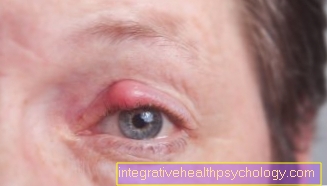
The Stye represents an acute bacterial inflammation of the Eyelids, more precisely the sebum and sweat glands found on the eyelid. Like conjunctivitis, stye is a common clinical picture and is mostly caused by skin germs such as staphylococci and in rare cases by streptococci. A typical symptom of a stye is the appearance of a painful, reddened and tender lumpthat can spontaneously evacuate with pus. After the lump is emptied, the stye usually heals without any complications from. Therapy is therefore only necessary in very few cases. However, if the infection has spread to the eye socket (a so-called Orbital phlegmon), antibiotic therapy with tablets or infusions, as well as exposure of the inflamed area (Incision) necessary. In order to prevent such a complication from the outset, eye drops containing antibiotics with gentamicin can be used prophylactic be prescribed.
Side effects
As with antibiotics administered as tablets, eye drops containing antibiotics also harbor the risk of allergic reaction. Long-term use can also damage the cornea with ulcerations.
Read our article on this: Antibiotic side effects
Interaction of the drops with alcohol
Basically, many antibiotics get along well with alcohol, which is why an absolute alcohol ban does not have to be pronounced. This also includes antibiotics that are used for eye diseases, e.g. Gentamycin, tetracyclines, doxycycline and ofloxacin. Because antibiotics in ophthalmology are mostly local, i.e. in the form of Drops or ointments, are administered, the effect of the antibiotics on the body is also much less pronounced than with a tablet or an infusion. The incoming dose and thus also the interaction of the antibiotic with alcohol is much lower and actually to neglect.
Despite everything, you should know that not all antibiotics tolerated with alcohol. Antibiotics like Metronidazole or Tinidazole inhibit, for example, the complete breakdown of alcohol by inhibiting an important enzyme that breaks down alcohol into harmless acetate. By inhibiting the enzyme it can become severe Symptoms of intoxication such as nausea, vomiting, headaches, shortness of breath and cardiac arrhythmias. This is also known as the "antabus effect". To avoid this complication, it is advisable during and up to 3 days after the end of therapy with metronidazole Refrain from drinking alcohol.
Even patients with acquaintances Liver or kidney disorders must not drink alcohol while taking antibiotics, as this would result in life-threatening complications. As a precaution, this should also be observed when taking eye drops containing antibiotics.
Interactions with the pill
Since antibiotics are mostly applied locally in the form of drops in ophthalmology, the effect of antibiotics on the body is very small. This is where it comes from usually does not cause interactions with the pill, which is why the pill is effective in eye drops containing antibiotics NOT repealed becomes.
However, if, for example, possible interactions with the pill or effects on the intestine (diarrhea) are described in the package insert of the antibiotic, pregnancy may be possible and a condom should be used for additional contraception during and up to 7 days after the end of antibiotic therapy . If the antibiotic should only be taken during the pill break, there is none additional contraception necessary.
Gentamycin, neomycin and kanamycin have usually also taken as a tablet, no interactions with the pill and can in principle be taken without any risk.
Drops containing antibiotics during pregnancy
Eye drops containing antibiotics should be used during pregnancy more careful and only used when necessary. Antibiotics like Gentamycin, kanamycin and neomycin may be used in the form of eye drops or eye ointments, as these only affect one small part in the body circulation recorded and therefore have hardly any or only very small doses on the maternal circulation.
Antibiotics like tetracycline or doxycycline can be used during pregnancy Liver damage evoke and should in principle not be prescribed. Ciprofloxacin should not be used in the form of eye drops either, as there are only a few studies that guarantee it is safe.
Read more about the topic here: Antibiotics in Pregnancy
Eye drops containing antibiotics during breastfeeding
When breastfeeding, many drugs must be questioned as to whether they can be taken despite breastfeeding. The question is always whether the active ingredient can be transferred from the breastfeeding mother to the child. If so, you should not breastfeed while the drug is being taken. It is possible that another drug with the same or a comparable mode of action can be taken, which does not pass into breast milk and therefore cannot be passed on to the breastfed child. Many eye drops are structured in such a way that the antibiotic they contain only works locally on the eye and little or no part of the active ingredient is absorbed into the body and the bloodstream. Therefore, the antibiotic eye drops can usually be taken during breastfeeding. However, since there are differences in the composition and effectiveness regardless of the active ingredient and the manufacturer, a doctor should always be consulted before taking antibiotic eye drops. In most cases, a note about pregnancy and breastfeeding can also be found in the package insert for eye drops containing antibiotics.
Read more on the subject at: Medication during breastfeeding
Drops containing antibiotics in infants and children
Especially with infants it can, due to the delayed development of the tear ducts easy conjunctivitis of the eyes. Due to the lack of tear ducts, the tear fluid can only drain with difficulty, which is why a small "tear lake" can form around the eyes. This in turn favor bacterial infections and inflammation. One in ten babies is affected by recurrent conjunctivitis. Typical symptoms are sticky, swollen eyes with purulent or slimy secretions. In these cases the doctor would try to open the lacrimal tubules with a small probe, thereby allowing a drainage and avoiding recurring conjunctivitis.
Eye drops containing antibiotics can also be used in young children.
Contraindications
Eye drops containing antibiotics should not be used if there is already ulceration of the cornea or if there is an allergy to the medication to be administered.








